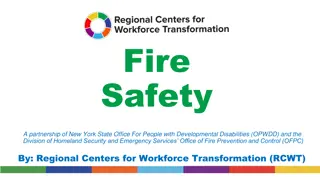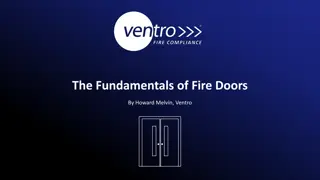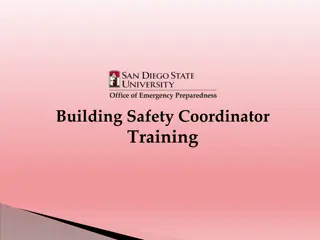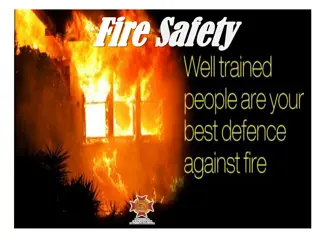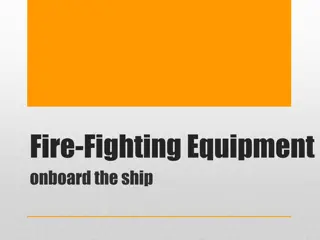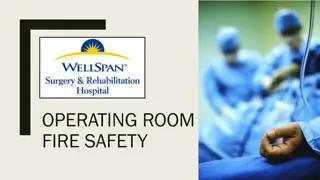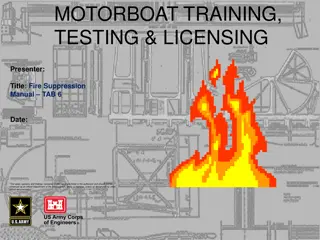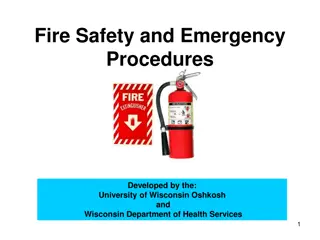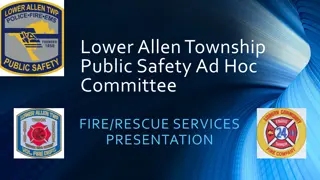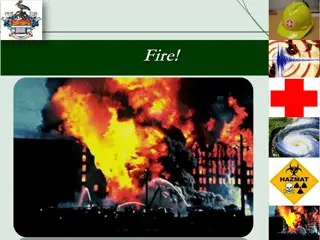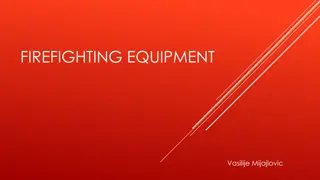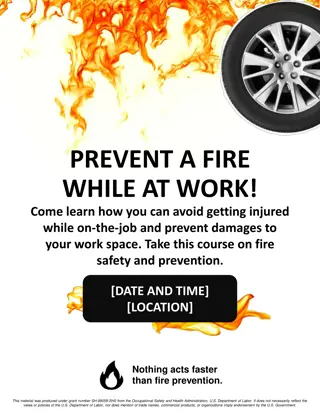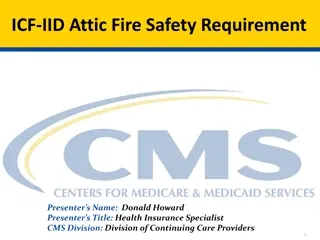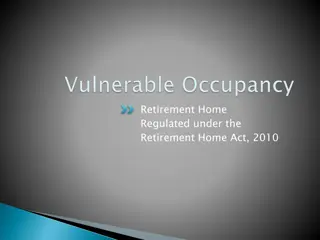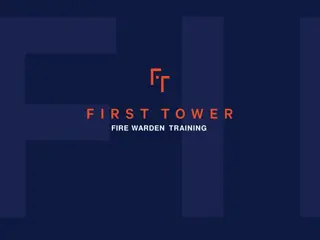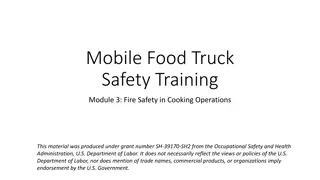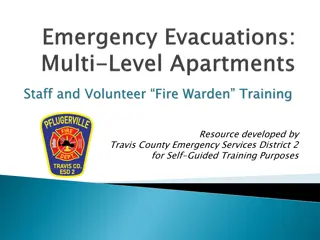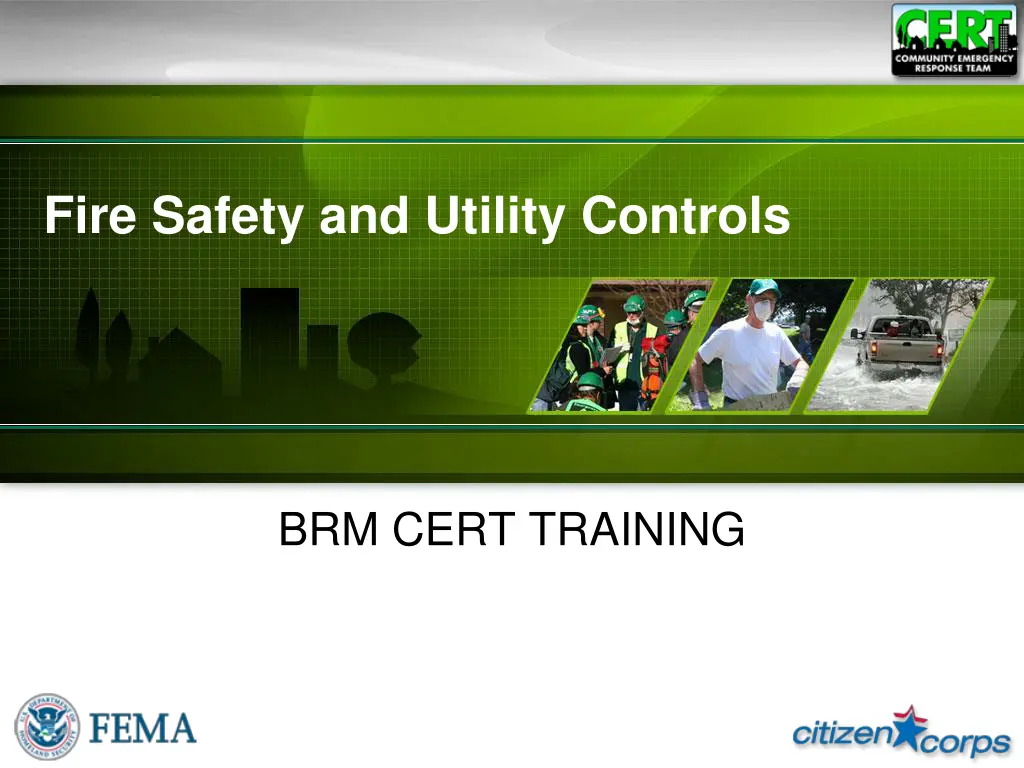
Fire Safety and Utility Controls Training Overview
Explore the fundamentals of fire safety and utility controls through images and key training objectives. Learn about the fire triangle, classes of fire, common causes of home fires, and ways to reduce electrical hazards to enhance safety at home. Stay informed and prepared to prevent fire incidents effectively.
Download Presentation

Please find below an Image/Link to download the presentation.
The content on the website is provided AS IS for your information and personal use only. It may not be sold, licensed, or shared on other websites without obtaining consent from the author. If you encounter any issues during the download, it is possible that the publisher has removed the file from their server.
You are allowed to download the files provided on this website for personal or commercial use, subject to the condition that they are used lawfully. All files are the property of their respective owners.
The content on the website is provided AS IS for your information and personal use only. It may not be sold, licensed, or shared on other websites without obtaining consent from the author.
E N D
Presentation Transcript
Fire Safety and Utility Controls BRM CERT TRAINING
Unit Objectives What is fire safety Identify and reduce potential fire hazards Explain basic safety precautions Home fire safety BRM CERT TRAINING 2-1
The Fire Triangle Heat Fuel Oxygen BRM CERT TRAINING 2-2
5 Classes of Fire A: Ordinary combustibles B: Flammable and combustible liquids C: Energized electrical equipment D: Combustible metals K: Cooking oils Why is knowing fire classes important? BRM CERT TRAINING 2-3
Home Fires What is the #1 cause of home fires? BRM CERT TRAINING 2-4
Home Fires Yes, cooking fires! BRM CERT TRAINING 2-5
Home Fires What is the #2 cause of home fires? BRM CERT TRAINING 2-6
Home Fires Electrical overload. BRM CERT TRAINING 2-7
Reducing Electrical Hazards Avoid the electrical octopus Don t run cords under carpets Check for and replace broken or frayed cords Maintain appliances BRM CERT TRAINING 2-8
Reducing Electrical Hazards This is a no no! BRM CERT TRAINING 2-9
Reducing Electrical Hazards Throw this extension cord away! BRM CERT TRAINING 2-10
Reducing Electrical Hazards What we find in homes: Microwave ovens plugged into a power strip Toasters left plugged in when not in use Wires running under a rug or carpet Cluttered power strips Not an electrical hazard: Cluttered hallways BRM CERT TRAINING 2-11
Electrical Emergencies Know where power shutoffs are for: Appliances Circuit breakers Fuses Post shutoff directions next to all utilities Know procedures for turning power back on BRM CERT TRAINING 2-12
Shutoff Procedures Circuit box with shutoff: What does shutoff mean? BRM CERT TRAINING 2-13
Shutoff Procedures Off On BRM CERT TRAINING 2-14
Other fire hazards Candles Smoking: Lit cigarette Matches Natural Gas BRM CERT TRAINING 2-15
Natural Gas Hazard Awareness Install natural gas detector Install carbon monoxide detector in home Test batteries for natural gas and carbon monoxide detectors every month Change batteries every 6 months Locate and label gas shutoffs Have proper non-sparking tool BRM CERT TRAINING 2-16
Gas Shutoff Locate and label gas shutoff valves If not automatic, know procedures for shutting off gas BRM CERT TRAINING 2-17
Gas Shutoff BRM CERT TRAINING 2-18
Smoke Alarms Typical smoke alarm Lithium Ion battery last 10 years If smoke alarm starts chirping, remove & replace smoke alarm Recommend testing once a month Placement: One in each bedroom & one in the hallway. Do not install in the kitchen or close to bathrooms, washer & dryer. BRM CERT TRAINING 2-19
Smoke Alarms Typical smoke alarm Light Clean Clean Test button BRM CERT TRAINING 2-20
Smoke Alarms Special Smoke Alarms: For the hearing impaired Bed Shakers Flashing Lights BRM CERT TRAINING 2-21
Smoke Alarms Purchase at City Mill, Home Depot, Lowes Or, call the American Red Cross 739-8111 BRM CERT TRAINING 2-22
Smoke Alarms Or, call the American Red Cross for the annual Smoke Alarms For Everyone (SAFE) HFD & IBEW retirees 739-8111 BRM CERT TRAINING 2-23
Smoke Alarms BRM CERT TRAINING 2-24
Fire Escape Plan The smoke alarm wakes you, what do you do? Does your family know what to do? BRM CERT TRAINING 2-25
Fire Escape Plan You hear the smoke alarm chirping. Roll out of the bed, stay low to the floor. Wake your family, you have two minutes to escape. Everyone follows the fire escape plan. Your family exits the house and meet at the designated meeting place. Now, call 911. BRM CERT TRAINING 2-26
Fire Escape Plan What happens if your family member is bed ridden? What happens if you have an infant? What happens if your primary escape route is blocked by fire? CERT Basic Training Unit 2: Fire Safety and Utility Controls 2-28
Firefighting Resources Portable fire extinguishers Extinguish Class A, B & C Check the pressure gauge If the fire extinguisher has been sitting idle for a long time, shuffle the fire extinguisher Pressure gauge Label CERT Basic Training Unit 2: Fire Safety and Utility Controls 2-29
Wild Fires Surface Fires: Fires that burn on the ground, usually leaves, grass, twigs Ground Fires: Fires that burn below the ground, usually roots, buried stumps, organic soil Crown Fires: Fires that ascend from the ground into the crown canopy of trees CERT Basic Training Unit 2: Fire Safety and Utility Controls 2-30
Unit Summary What is fire safety Identify and reduce potential fire hazards Explain basic safety precautions Home fire safety CERT Basic Training Unit 2: Fire Safety and Utility Controls 2-31

